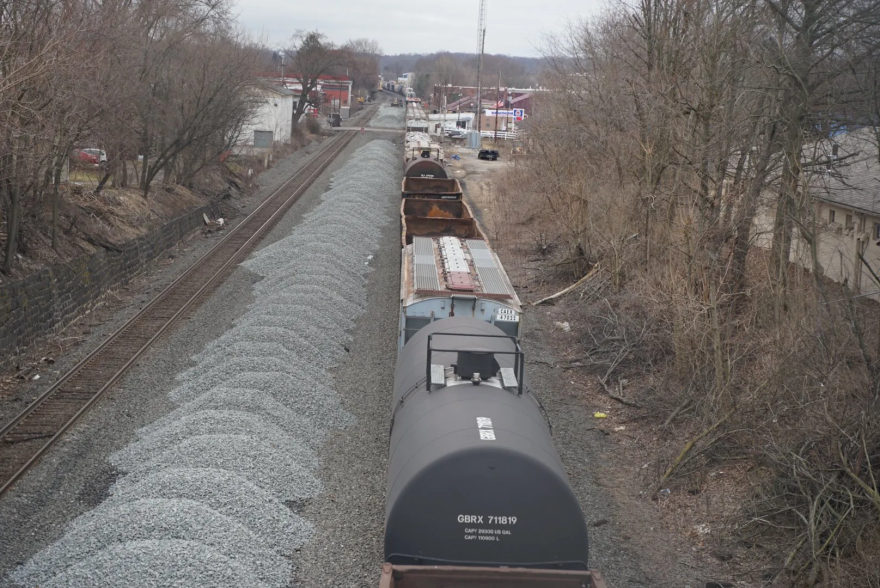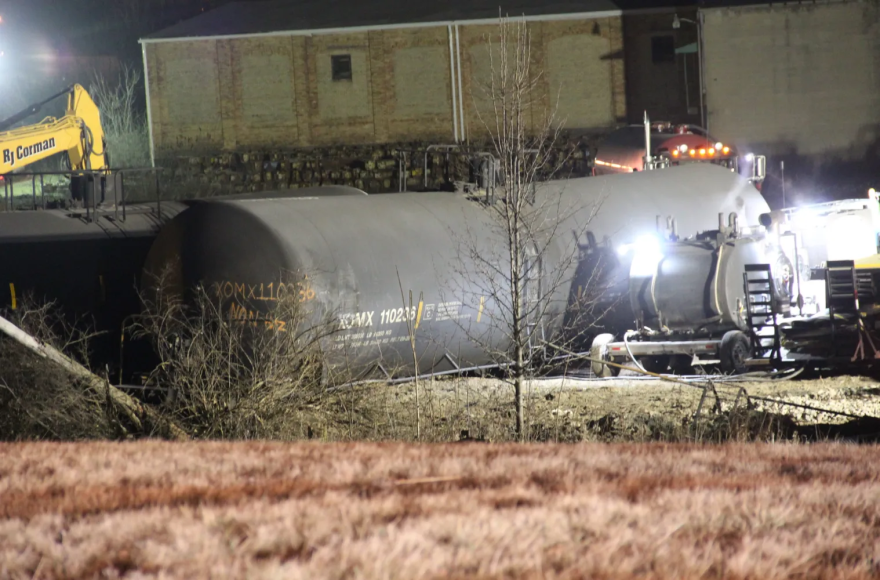EAST PALESTINE, Ohio - In a press conference following the catastrophic derailment in East Palestine, Ohio Governor Mike DeWine expressed difficulty grasping one particular aspect of federal rail regulations.
- There was a catastrophic train derailment in East Palestine
- Ohio Governor Mike DeWine has expressed his incredulity at existing federal rail regulations.
- In particular, the train itself was not considered high-hazardous, despite having 20 cars of hazardous materials
“This train…was not considered high hazardous material train,” DeWine said. “Frankly, if this is true – and I’m told it’s true – this is absurd, and we need to look at this.”
The National Transportation Safety Board – the federal agency investigating the crash – says it is looking at a damaged wheel bearing on one of the cars in the Norfolk Southern train as a possible cause for the Feb. 3 crash.
In the aftermath of the derailment, which released toxic chemicals into the streams and air around East Palestine, many are wondering how the country’s regulations around rail traffic could have allowed a train with 20 cars of hazardous material not to be considered a “high hazard.” And could stronger regulations have prevented it from happening?
All four U.S. Senators from Ohio and Pennsylvania say they’ll push for new rules to prevent a similar disaster in the future.
To do that, the rules federal regulators wrote a few years ago regarding hazardous train cargo will likely need to be revisited, experts say. These rules were written during a period of high-profile rail accidents involving crude oil trains, including the Lac-Mégantic, Quebec disaster in 2013 that killed 47.
But ultimately, regulators allowed exemptions in the rules that the Norfolk Southern train was operating under when it derailed.
The final rules, published in 2015, mandated tighter regulations for “high-hazard flammable trains.” But the government defined these as trains carrying crude oil and other liquid fuels. Flammable gases like vinyl chloride were excluded from the regulations, against the recommendations of the National Transportation Safety Board.
The NTSB also recommended these trains have electronically controlled pneumatic braking systems, which studies have shown are better than the kinds of air brakes that were on the Norfolk Southern train.
The rules, finalized under the Obama administration, originally mandated that these trains have electronic brakes. But after lobbying by the rail industry, the Trump administration rescinded those rules. So far, the Biden administration has not yet signaled an appetite to revisit them.
Would electronic brakes have lessened the derailment?
Traditional air brakes, like the kind the Norfolk Southern train was equipped with, work by pushing a pulse of compressed air along a train that triggers brakes on individual cars. That pulse moves quickly, but there can be a slight delay between when cars in the front begin braking and those in the rear.
“The cars in the rear that are still rolling have momentum, and there’s nothing quite slowing them down,” said Steven Ditmeyer, a former Federal Railroad Administration official.
By contrast, electronic brake systems send the brake signal at the speed of light during a derailment.
“All the brakes go on simultaneously, which shortens the braking distance and reduces the pressure on the train from the rear to the front,” Ditmeyer said.
Michael Paul Lindsey, a locomotive engineer who worked in the industry for 17 years, mostly out in the West, said electronic brakes would not have prevented the accident. But they might have decreased the number of cars that derailed.
“Every single car on the train would have went into emergency at once at the same time,” he said. A build-up of pressure, or a “slack run,” was less likely to have happened, and fewer cars may have derailed. “The fire may never have even happened.”
Federal regulators stress looking for causes of the accident is premature.
“We strongly caution all parties against premature speculation and conjecture regarding the probable cause, methods of prevention, or potential contributing factors,” Federal Railroad Administration spokesman Warren Flatau said in a statement.

Precision Scheduled Railroading
Another aspect of the wreck that has drawn scrutiny is the train’s size. At 150 cars, it was over a mile and a half long.
“The railroads are running longer trains than before, and longer trains, when there’s a failure of a component, have bigger accidents,” Ditmeyer said.
Larger trains are a trend going back a few years with a concept called Precision Scheduled Railroading. Under this trend, big rail companies, including Norfolk Southern, cut costs by reducing staff by around 30 percent. They also cut rail routes and began increasing the length of their trains.
“Wall Street rewarded railroad his railroads for doing this by raising the value of the stock.”Steven Ditmeyer, former Federal Railroad Administration official
“Wall Street loved it,” Ditmeyer said. “Wall Street rewarded railroad his railroads for doing this by raising the value of the stock.”
Norfolk Southern did so well that the company spent $10 billion last year to buy back its own stock.
Rail worker unions have criticized companies’ focus on cost-cutting. Lindsey, the locomotive engineer, says he worries it could erode safety. He says companies emphasize the need to get cars out of railyards quickly and on to their next destination.
“The entire railroad kind of fights each other where terminal managers in one terminal will send a train down the line that has mechanical problems,” he said. “[The attitude is] just get it out of the terminal. Let them deal with it.”
Norfolk Southern officials bowed out of a public meeting on the derailment on Wednesday. Calls to the company on the topic were not returned.
Allan Zarembski, director of the Railroad Engineering and Safety program at the University of Delaware, says the rush to judge Norfolk Southern is understandable but may be misplaced.
“You have to realize we’re dealing with very rare events,” said Zarembski, whose work is largely funded by the federal government, with a “modest amount” of research funding from rail companies.
Zarembski said one advantage of long trains is there are fewer train trips. He thinks that increases overall safety. “If I triple the number of trains I have to run, am I safer?” Zarembski asked.
He agrees that electronic brakes would make hazardous material trains safer. But he said mandating them would create a whole new set of logistical problems for putting together cargo trains, and it would cost in the billions.
“It’s very hard to convert every freight car in the United States to have an electrical connection because they don’t have them right now,” he said. “The question, you know, it’s a classic question: Do you spend $100 million to save $1 million? If it’s spending $1 million to save $1 million, that’s usually a no-brainer. Do you spend $100 million to save $1 million? That’s where it gets a lot more complex.”
Zarembski worries more regulation could push freight customers to use more dangerous modes of transportation, like trucks. There are only about 14 hazardous material derailments a year in the US, according to federal data.
“I want improved operations. But I want to do that in such a way that I do not make my railway system less efficient, does not make my railway system less productive. And does not force me to go to a mode [of transportation] that I know is much less safe,” Zarembski said. “So we’re walking that fine line.”

